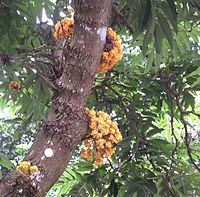Difference between revisions of "Saraca cauliflora"
From Gardenology.org - Plant Encyclopedia and Gardening Wiki
Jump to navigationJump to search (New page: __NOTOC__{{Plantbox | name = ''LATINNAME'' <!--- replace LATINNAME with the actual latin name --> | common_names = <!--- if multiple, list all, if none, leave blank --> | growth_habi...) |
|||
| (One intermediate revision by one other user not shown) | |||
| Line 1: | Line 1: | ||
| − | + | {{SPlantbox | |
| − | | | + | |familia=Fabaceae |
| − | | | + | |genus=Saraca |
| − | | | + | |species=cauliflora |
| − | | | + | |habit=tree |
| − | | | + | |habit_ref=Flora - A Gardener's Encyclopedia |
| − | | | + | |Max ht box=30 |
| − | | | + | |Max ht metric=ft |
| − | | lifespan = | + | |height_ref=Flora - A Gardener's Encyclopedia |
| − | | exposure = | + | |Max wd box=25 |
| − | | | + | |Max wd metric=ft |
| − | | features = | + | |width_ref=Flora - A Gardener's Encyclopedia |
| − | | | + | |lifespan=perennial |
| − | | | + | |life_ref=Flora - A Gardener's Encyclopedia |
| − | | | + | |exposure=shade |
| − | | | + | |sun_ref=Flora - A Gardener's Encyclopedia |
| − | | | + | |features=flowers |
| − | | image = | + | |flower_season=early spring, mid spring, late spring, early winter, mid winter, late winter |
| − | | image_width = | + | |flowers=red, orange, yellow, pink |
| − | + | |Temp Metric=°F | |
| − | + | |min_zone=11 | |
| − | + | |usda_ref=Flora - A Gardener's Encyclopedia | |
| − | + | |max_zone=12 | |
| − | + | |image=Saraca cauliflora.jpg | |
| − | + | |image_width=200 | |
| − | |||
| − | |||
| − | |||
| − | |||
}} | }} | ||
| + | Describe this plant here... | ||
| + | |||
{{Inc| | {{Inc| | ||
| − | |||
Saraca cauliflora, Baker. A shrubby tree: lfts. 10-12, rigidly subcoriaceous, the upper oblanceolate-oblong, acute, 1 ft. or more long, the lower shorter, more oblong: corymbs solitary or in pairs, nearly sessile, dense, 4-6 in. broad: fls. scarlet; stamens 7. India.—Intro. into S. Fla. | Saraca cauliflora, Baker. A shrubby tree: lfts. 10-12, rigidly subcoriaceous, the upper oblanceolate-oblong, acute, 1 ft. or more long, the lower shorter, more oblong: corymbs solitary or in pairs, nearly sessile, dense, 4-6 in. broad: fls. scarlet; stamens 7. India.—Intro. into S. Fla. | ||
{{SCH}} | {{SCH}} | ||
| Line 36: | Line 33: | ||
==Cultivation== | ==Cultivation== | ||
| − | + | ||
===Propagation=== | ===Propagation=== | ||
| − | + | ||
===Pests and diseases=== | ===Pests and diseases=== | ||
| − | |||
| − | == | + | |
| − | + | ==Varieties== | |
| + | |||
==Gallery== | ==Gallery== | ||
| − | |||
| − | <gallery> | + | <gallery perrow=5> |
Image:Upload.png| photo 1 | Image:Upload.png| photo 1 | ||
Image:Upload.png| photo 2 | Image:Upload.png| photo 2 | ||
| Line 57: | Line 53: | ||
==References== | ==References== | ||
| + | <references/> | ||
*[[Standard Cyclopedia of Horticulture]], by L. H. Bailey, MacMillan Co., 1963 | *[[Standard Cyclopedia of Horticulture]], by L. H. Bailey, MacMillan Co., 1963 | ||
<!--- xxxxx *Flora: The Gardener's Bible, by Sean Hogan. Global Book Publishing, 2003. ISBN 0881925381 --> | <!--- xxxxx *Flora: The Gardener's Bible, by Sean Hogan. Global Book Publishing, 2003. ISBN 0881925381 --> | ||
| Line 66: | Line 63: | ||
{{stub}} | {{stub}} | ||
| − | + | __NOTOC__ | |
| − | |||
| − | |||
Latest revision as of 15:48, 14 May 2010
| Habit | tree
| |
|---|---|---|
| Height: | ⇕ | 30 ft"ft" can not be assigned to a declared number type with value 30. |
| Width: | ⇔ | 25 ft"ft" can not be assigned to a declared number type with value 25. |
| Lifespan: | ⌛ | perennial |
| Bloom: | ❀ | early spring, mid spring, late spring, early winter, mid winter, late winter |
| Exposure: | ☼ | shade |
|---|---|---|
| Features: | ✓ | flowers |
| USDA Zones: | 11 to 12 | |
| Flower features: | ❀ | red, orange, yellow, pink |
|
Fabaceae > |
Saraca > |
Describe this plant here...
Read about Saraca cauliflora in the Standard Cyclopedia of Horticulture
|
|---|
|
Saraca cauliflora, Baker. A shrubby tree: lfts. 10-12, rigidly subcoriaceous, the upper oblanceolate-oblong, acute, 1 ft. or more long, the lower shorter, more oblong: corymbs solitary or in pairs, nearly sessile, dense, 4-6 in. broad: fls. scarlet; stamens 7. India.—Intro. into S. Fla. CH
|
Cultivation
Propagation
Pests and diseases
Varieties
Gallery
References
- Standard Cyclopedia of Horticulture, by L. H. Bailey, MacMillan Co., 1963
External links
- w:Saraca cauliflora. Some of the material on this page may be from Wikipedia, under the Creative Commons license.
- Saraca cauliflora QR Code (Size 50, 100, 200, 500)

